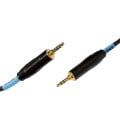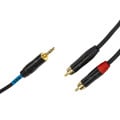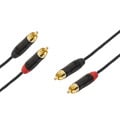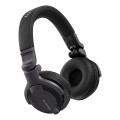PreSonus StudioLive 32R to 32-kanałowy stagebox i mikser rackowy serii III.
Nie tylko stagebox
Mikser rackowy/rekorder StudioLive 32R serii III to idealny partner dla konsolety/rekordera StudioLive serii III i może służyć jako prosty stagebox AVB, połączenie stageboxa i miksera monitorowego lub jako najpotężniejszy, samodzielny mikser rackowy w swojej klasie, dający wiele możliwości dostosowania sposobu pracy i działania do własnych potrzeb. Mikser rackowy III generacji ma pamięć wszystkich ustawień, łącznie z parametrami preampów XMAX na wszystkich kanałach wejściowych. Pożądane brzmienie StudioLive jest jeszcze lepsze niż wcześniej i obejmuje przetwarzanie Fat Channel serii III, z korektorami i kompresorami vintage na każdym kanale, i sześciopasmowy, w pełni parametryczny EQ na wszystkich wyjściach miksu.
Łatwa obsługa i zdalne sterowanie
Mikser rackowy StudioLive III jest łatwy w obsłudze i zapewnia wiele możliwości dopasowania sposobu pracy do własnych preferencji. Masz 16 Flexmiksów, które można indywidualnie wyznaczać jako aux, subgrupę lub miks matrix, co pozwala na miksowanie i dopasowywanie typów szyn według potrzeby. Presety Fat Channel w serii III stały się czymś w rodzaju scen dla poszczególnych kanałów: nie tylko zachowują ustawienia wejścia i Fat Channel, lecz także konfigurację wysyłek i szyn. Tak jak w przypadku konsolet serii III, możesz sterować mikserem przy pomocy wielu iPadów i komputerów, każdy z uruchomioną aplikacją UC Surface, z różnymi widokami, co umożliwia podgląd i regulację elementów, których potrzebujesz w danym czasie.
Sieć AVB
PreSonus StudioLive 32R posiada obsługę sieci AVB dla nagrywania oraz kompatybilności z urządzeniami AVB. StudioLive 32R serii III zapewnia trzy sposoby wielościeżkowego nagrywania. Dostępne jest pokładowe nagrywanie w stereo na kartę SD, które nie wymaga komputera; nagrywanie 40×40 przez USB 2.0 na komputer Mac lub Windows; lub nagrywanie 55×55 na komputer przez sieć AVB. Nagrywanie odbywa się przy pomocy Capture, Studio One 3 (polska wersja językowa) lub każdego innego oprogramowania, które obsługuje ASIO lub Core Audio. Port Ethernet 1 GB służy do połączenia z routerem bezprzewodowym lub bezpośrednio z komputerem, co umożliwia miksowanie bezprzewodowe lub przez sieć kablową z każdego miejsca przy użyciu UC Surface dla komputerów Mac/Windows, iPada bądź urządzenia z… Androidem! Mamy więc pełną kontrolę nad mikserem.
Zestaw darmowego i uniwersalnego oprogramowania
UC Surface jest częścią PreSonus Series III Software Library, kolekcji najnowocześniejszego oprogramowania, które jest ściśle zintegrowane z konsoletami i mikserami rackowymi serii III. Zestaw oprogramowania zawiera także łatwy w obsłudze polskojęzyczny program DAW PreSonusa – Studio One 3 Artist na komputery Mac i Windows, który zapewnia nagrywanie przy niskiej latencji z efektami, zdalną obsługą preampów XMAX i przetwarzaniem Fat Channel z miksera rackowego StudioLive serii III. Automatyzacja wirtualnych prób, a także nagrywanie jest możliwe przy pomocy programu Capture dla Mac i Windows. Muzycy mogą regulować swoje miksy odsłuchowe przy pomocy QMix-UC na iPhone’a, iPoda i urządzenia z Androidem. Wszystko to zostało zawarte w pakiecie oprogramowania.
Cechy StudioLive 32R
32-kanałowy stagebox AVB do konsolet StudioLive serii III
– Tryb prostego stageboksa,
– Tryb stagebox + mikser monitorowy z regulacją preampów i zasilania fantomowego z konsolety StudioLive serii III,
32-kanałowy cyfrowy mikser rackowy z pełną pamięcią ustawień,
34 wejścia ogółem:
– 32 blokowane wejścia combo mikrofonowe/liniowe z przedwzmacniaczami mikrofonowymi XMAX pracującymi w klasie A, z pamięcią ustawień,
– 2 kanały wejściowe RCA o poziomie liniowym (kanały 31-32),
16 wyjść FlexMix TRS 1/4″,
2 główne wyjścia XLR (lewe/prawe),
Zarządzanie scenami przy pomocy Scene Safe,
16 x FlexMix (miksy aux, subgrupy lub Matrix),
4 osobne subgrupy,
4 wewnętrzne szyny efektów (połączenie pogłosów i delayów z opcjami: modern lub vintage),
Przetwarzanie Fat Channel – korektor i kompresor z opcjami vintage na każdym kanale oraz porównywaniem A/B,
Interfejs do nagrywania USB 2.0 40×40 i interfejs do nagrywania AVB 55×55,
Pokładowe nagrywanie stereo na kartę SD,
Kompletne rozwiązanie: Zawiera oprogramowanie do dotykowej obsługi UC Surface na urządzenia/komputery: Mac, Windows, iPad i Android; oprogramowanie do nagrywania Capture oraz program DAW Studio One na komputery Mac i Windows; zgodny z QMix-UC – darmową aplikacją do regulacji osobistego odsłuchu na iPhone’a/iPoda touch i urządzenia z Androidem.
The StudioLive 32R Series III rack mixer is a perfect partner for your StudioLive Series III console/recorder, serving as either a simple stage box or a combination stage box and monitor mixer. Since Series III rack mixers and consoles can network using AVB, you can connect your StudioLive 32R to a Series III front-of-house console with one lightweight CAT5e or CAT6 Ethernet cable, eliminating the need for a heavy, expensive copper snake—and the signal degradation that goes with long analog cable runs. You can even remote control the StudioLive 32R’s preamps and phantom power from your networked Series III console. In stage box + monitor mixer mode, the StudioLive 32R not only serves as an excellent networked stage box, it is a full blown monitor mixer with far more processing and mixing power than any mixer in its class—all packed into just two rackspaces (2U).
When we say the StudioLive® 32R Series III stage box and rack mixer is by far the most powerful rackmount digital mixer in its class, that’s no idle claim. The result of ten years of R&D, third-generation StudioLive Series III rack mixers are fully recallable, including remote-controlled XMAX preamps. Yet despite their extensive features, StudioLive Series III rack mixers actually improve upon PreSonus®’ legendary ease of use while letting you customize their workflow and operations in software to fit the way you work. The coveted StudioLive sound is better than ever, including third-generation Fat Channel processing, re-engineered from the ground up, and vintage-style EQs and compressors. Add built-in AVB networking, multitrack recording via USB 2.0 and AVB, onboard stereo recording to SD Card, and a complete suite of software, and you have a mixing and recording powerhouse that’s equally formidable as a stage box/monitor mixer, as a rackmount front-of-house mixer controlled from a touchscreen computer or tablet, and as the heart of your studio.
Features
Local Inputs and Outputs
- 34 total inputs
- 32 min/line channel inputs + 2 RCA inputs
- 16 ¼-inch TRS FlexMix outputs
- 2 XLR (L/R) Main outputs
- Stereo headphone output
Channels and Buses
- 32 input channels
- 2 stereo aux inputs (AVB or USB)
- 1 stereo digital return (SD Card, AVB, or USB)
- 26 buses:
- 16 FlexMixes (can be designated as aux, subgroup, or matrix mixes)
- 4 dedicated subgroups
- 4 internal effects sends
- Stereo main bus
- 24 Filter DCAs for easily and flexibly controlling groups of channels
Networking Connections
- 1 Ethernet control network port
- Dynamic, Self Assigned, and Manual IP address modes
- 1 Locking XLR Ethernet AVB audio network port
Recording
- Onboard stereo SD recorder
- 40x40 USB recording interface
- 55x55 AVB recording interface
Signal Processing
- Intuitive Fat Channel signal processing on every channel with:
- A/B settings comparison
- Highpass filter and polarity reverse
- Gate/expander with sidechain
- Compressor with sidechain
- 4-band parametric EQ on inputs
- 6-band parametric EQ on outputs
- Limiter
- Delay on every input
- Delay on every output
- Professionally programmed library of presets
- Vintage EQ and compressor models available on every input
- Passive EQ
- Vintage EQ
- Tube compressor
- FET compressor
- 8 31-band graphic EQs
- 4 internal effects buses: combination of reverbs and delays with modern and vintage options
- Built-in real-time analyzer
Scenes and Presets
- Create, save, and edit up to 100 scenes
- Scene management with:
- Scene Safe—prevents a scene change from affecting designated “safe” channels
- Create, save, and edit channel settings and copy/paste between channels
- Advanced channel preset options can save and recall:
- Channel type and name
- Input settings (preamp, +48V phantom power, polarity, pan)
- Fat Channel A & B settings
- Bus assignments
- Aux and effects send levels and pan
- Select button color
- 8 Quick Scenes
- 8 Mute groups
Digital
- Studio-quality converters with 115 dB dynamic range
- 48 kHz operation with 24-bit resolution (44.1 kHz option coming soon)
Actively Integrated Software
- UC Surface touch control software for Mac®, Windows®, iPad®, and Android ™
- Studio One® Artist digital audio workstation software for Mac and Windows
- Capture™ multitrack recording software for Mac and Windows
- QMix®-UC aux-control software for iOS® and Android™ available free from Apple App Store and Google Play
Computer system requirements:
Below are the minimum computer-system requirements for UC Surface, QMix®-UC, and Studio One®.
Mac
- Mac® OS X 10.8.5 64-bit or later
- Intel® Core™ 2 Duo processor (Intel Core i3 or faster recommended)
- 4 GB RAM (8 GB or more recommended)
Windows
- Windows® 7 x64/x86 SP1 + platform update, Windows 8.1 x64/x86, Windows 10 x64/x86
- Intel Core 2 Duo (Intel Core i3 or faster recommended)
- 4 GB RAM (8 GB or more recommended)
Mac and Windows Systems
- USB 2.0 port
- Internet connection
- Internal or external 7200 RPM storage drive highly recommended
- 34 GB hard disk space
- Monitor with 1366x768 resolution
iOS
- iOS 9.3 or later
- iPad Pro, iPad Air 2, iPad Air, iPad mini 4, iPad mini with Retina display, iPad (4th generation), iPad mini, iPad (3rd generation), iPad 2
Android (QMix-UC)
- Android™ 5.0 (Lollipop) or later
- Android smartphone (QMix-UC)
- Android tablet (8-inch) with 1024x768 resolution (UC Surface)
Technical Specifications:
Microphone Preamplifier
Input Type Combo locking XLR mic-¼” TRS line
Frequency Response to Main Output (at unity gain) 20-20 kHz, ±0.5 dBu
Input Impedance 1 kΩ
THD to Main Output <0.005%, +4 dBu, 20-20 kHz, unity gain, unwtd
S/N Ratio to Main Output (Ref = +4 dB, 20 kHz BW, unity gain, A-wtd) 94 dB
Common Mode Rejection Ratio (1 kHz at unity gain) 65 dB
Gain Control Range (±1 dB) 0 dB to +60 dB
Maximum Input Level (unity gain) +12 dBu
Phantom Power (±2 VDC) 48 VDC, switchable per channel
Unbalanced Inputs (Ch. 31-32)
Type RCA Female, unbalanced (stereo pair)
Maximum Input Level +12 dBu, ±0.5 dBu
Main Outputs
Type XLR Male, balanced
Maximum Output Level +24 dBu, ±0.5 dBu
Output Impedance 100Ω
Mix Outputs
Type ¼” TRS Female, balanced
Maximum Output Level +18 dBu, ±0.5 dBu
Output Impedance 100Ω
Headphone Output
Type ¼” TRS Female, active stereo
Maximum Output 100 mW/ch. @ 60Ω load
Frequency Response 20 Hz – 20 kHz (± 0.5 dB)
THD+N 0.01%, 1 kHz, max gain, 20 Hz BW, unwtd
S/N Ratio 96 dB, 1 kHz, max gain, 20 Hz BW, unwtd
System Crosstalk
Input to Output -90 dB (Ref = +4 dBu, 20 Hz-20 kHz, unwtd)
Adjacent Channels -87 dB (Ref = +4 dBu, 20 Hz-20 kHz, unwtd)
Digital Audio and Control
ADC Dynamic Range 115 dB (A-wtd, 48 kHz)
DAC Dynamic Range 115 dB (A-wtd, 48 kHz)
USB Recording Port USB 2.0, Type-B
Network Control Port RJ-45
AVB Audio Network Port Locking XLR Ethernet
Internal Processing 32-bit, floating point
Sampling Rate 48 kHz (44.1 kHz coming soon)
A/D/A Bit Depth 24
Reference Level for 0 dBFS +18 dBu
Total System Latency 1.9 ms (local routing, analog in-analog out, all processing active)
Clock
Jitter <20 ps RMS (20 Hz - 20 kHz)
Jitter Attenuation >60 dB (1 ns in, 1 ps out)
Power / Environmental
Connector IEC
Input-Voltage Range 90 to 230 VAC (±10%)
Power Requirements (continuous) 85W
Recommended Ambient Operating Temperature 0˚ to 40˚ Celsius / 32˚ to 104˚ Fahrenheit
Physical
Height 3.5” (90mm)
Width 19” (483mm)
Depth 12” (305mm)
Weight 11.2 lbs. (5 kg)

Firma
Produkty
Statystyki napraw



















